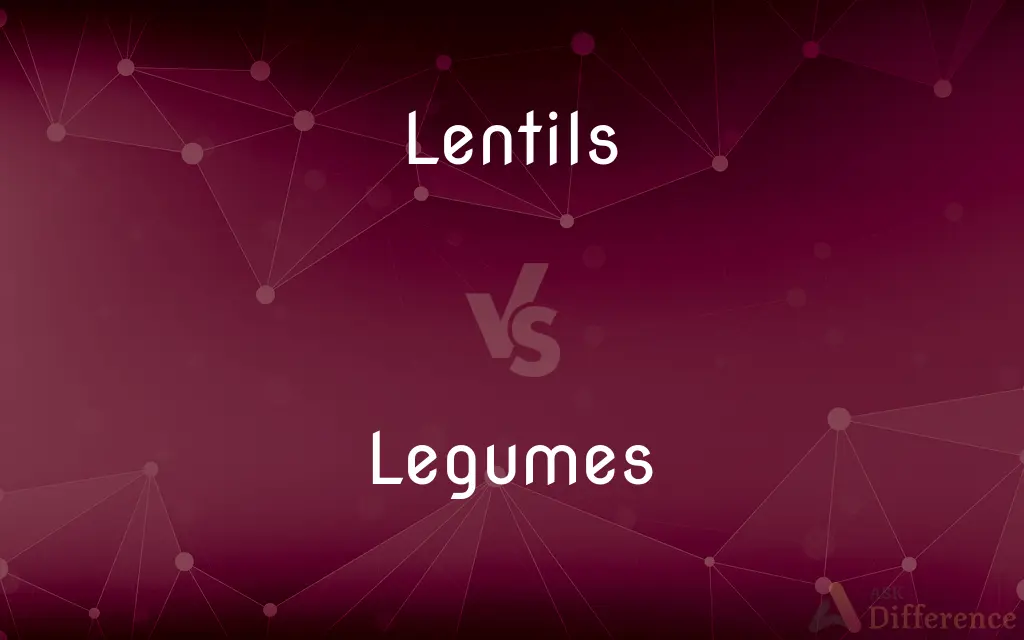Lentils vs. Legumes — What's the Difference?
Edited by Tayyaba Rehman — By Fiza Rafique — Updated on March 21, 2024
Lentils are a type of legume, known for their lens shape and quick cooking time, whereas legumes are a family of plants including beans, peas, and lentils.

Difference Between Lentils and Legumes
Table of Contents
ADVERTISEMENT
Key Differences
Lentils, specifically, are a member of this large family, distinguished by their small, lens-shaped seeds, which come in a range of colors like green, red, brown, and black. Legumes represent a broad category of plants that produce a pod with seeds inside, encompassing a variety of foods including beans, peas, chickpeas, peanuts, and lentils.
Lentils are particularly prized for their dietary benefits, including high protein and fiber content with low levels of fat, making them an excellent nutritional choice, especially for vegetarian and vegan diets. Legumes, in general, share these nutritional benefits, but the protein and fiber contents can vary significantly from one type to another.
One of the key distinctions between lentils and other legumes is the cooking time. Lentils typically require no pre-soaking and can be cooked in a relatively short period, ranging from 15 to 30 minutes depending on the type, making them a convenient option for quick meals. In contrast, many other legumes, like dried beans, often require soaking for several hours or overnight and a longer cooking time to become tender.
Lentils are used worldwide in a variety of dishes, from Indian dal and Middle Eastern salads to European soups and stews. The broader category of legumes is similarly versatile, finding its way into a wide range of culinary traditions, with each type of legume offering its own unique texture and flavor to dishes.
Environmental sustainability is another noteworthy aspect, where lentils, like many legumes, play a beneficial role in crop rotation and soil health. They have the ability to fix nitrogen in the soil, reducing the need for synthetic fertilizers, making them an environmentally friendly agricultural choice.
ADVERTISEMENT
Comparison Chart
Definition
A small, lens-shaped legume available in various colors.
A family of plants producing a pod with seeds inside.
Types Included
Green, red, brown, black lentils, etc.
Beans, peas, chickpeas, peanuts, lentils, etc.
Nutritional Value
High in protein and fiber, low in fat.
Varies, but generally high in protein and fiber.
Cooking Time
No soaking required, cooks in 15-30 minutes.
Many require soaking and longer cooking times.
Culinary Uses
Used in dal, soups, salads, and stews.
Versatile use in various cuisines.
Environmental Impact
Fixes nitrogen in the soil, reducing fertilizer need.
Generally beneficial for soil health and sustainability.
Compare with Definitions
Lentils
Quick Cooking Time.
Red lentils can be cooked in about 15 minutes.
Legumes
Broad Family Including Many Foods.
Legumes include beans, peas, and lentils.
Lentils
High in Protein and Fiber.
Lentils are a great protein source for vegetarians.
Legumes
Used in Diverse Cuisines.
Legumes are staples in diets worldwide, from hummus to chili.
Lentils
Versatile in Cooking.
Lentils are used in a variety of dishes around the world.
Legumes
Often Require Soaking.
Black beans need to be soaked before cooking.
Lentils
No Pre-Soaking Required.
Unlike many beans, lentils can be cooked directly.
Legumes
Eco-Friendly Crop Choice.
Many legumes improve soil health through nitrogen fixation.
Lentils
Nutritional Powerhouse.
They're low in fat and high in essential nutrients.
Legumes
Varied Nutritional Profiles.
Chickpeas are high in protein; peanuts are high in fat.
Lentils
A leguminous plant (Lens culinaris) native to southwest Asia, having flat pods containing lens-shaped, edible seeds.
Legumes
A plant of the pea family.
Lentils
The round, flattened seed of this plant.
Legumes
A pod of such a plant, which splits into two valves with the seeds attached to one edge of the valves.
Lentils
Plural of lentil
Legumes
Such a pod or seed used as food. Peas, beans, and lentils are legumes.
Legumes
Plural of legume
Common Curiosities
Are lentils suitable for all diets?
Yes, lentils are excellent for vegetarians, vegans, and those looking to add more plant-based proteins and fiber to their diets.
Why are lentils considered environmentally friendly?
They fix nitrogen in the soil, which can reduce the need for chemical fertilizers.
What makes lentils a type of legume?
Lentils are classified as legumes because they grow in pods, a characteristic of the legume family.
Are all legumes as quick to cook as lentils?
No, most legumes require longer cooking times and often need to be soaked first, unlike lentils.
Can lentils be eaten raw?
No, lentils need to be cooked to be digestible and safe to eat.
Why do some legumes require soaking?
Soaking helps to soften the beans, reduce cooking time, and eliminate substances that can cause indigestion.
What's the best way to incorporate lentils into a diet?
They can be added to soups, salads, and stews or used as a meat substitute in many recipes.
How do legumes benefit soil health?
Many legumes, including lentils, host bacteria that fix atmospheric nitrogen into the soil, enriching it for future crops.
Can lentils replace other legumes nutritionally?
Lentils can substitute for other legumes in terms of protein and fiber but may vary in other nutrients.
Is there a difference in taste between lentils and other legumes?
Yes, each type of legume has its own unique taste and texture, offering a wide range of culinary possibilities.
How do I choose between lentils and other legumes?
Consider cooking time, nutritional needs, and the specific flavor or texture you want for your dish.
How do the nutritional values of lentils and beans compare?
Both are high in protein and fiber, but specific nutritional values vary between types. Lentils often have less fat.
Are lentils gluten-free?
Yes, lentils are naturally gluten-free, making them a great option for those with gluten sensitivities.
Do lentils and other legumes have the same effect on digestion?
While all legumes are high in fiber and may cause gas, the effect varies by type and individual digestion. Soaking and rinsing can help reduce these effects for legumes that require it.
What are some popular dishes made with lentils?
Dishes like Indian dal, lentil soup, and salads are popular.
Share Your Discovery

Previous Comparison
Last vs. Next
Next Comparison
Ultra vs. InfraAuthor Spotlight
Written by
Fiza RafiqueFiza Rafique is a skilled content writer at AskDifference.com, where she meticulously refines and enhances written pieces. Drawing from her vast editorial expertise, Fiza ensures clarity, accuracy, and precision in every article. Passionate about language, she continually seeks to elevate the quality of content for readers worldwide.
Edited by
Tayyaba RehmanTayyaba Rehman is a distinguished writer, currently serving as a primary contributor to askdifference.com. As a researcher in semantics and etymology, Tayyaba's passion for the complexity of languages and their distinctions has found a perfect home on the platform. Tayyaba delves into the intricacies of language, distinguishing between commonly confused words and phrases, thereby providing clarity for readers worldwide.















































